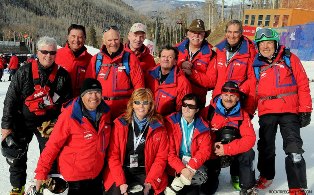The O. Zone
In an ever-warming world, Colorado’s long-running oil-shale experiment may finally be dead
One of the strongest arguments I’ve heard against continuing to pursue commercial oil shale production on Colorado’s Western Slope has always been the expense. In an ever-warming world, billions pumped into an unproven fossil-fuel technology would be better spent perfecting renewable forms of energy such as wind, solar and geothermal, oil-shale opponents have long argued.
On the day the United Nations’ Intergovernmental Panel on Climate Change concluded it’s “extremely likely that human influence has been the dominant cause of the observed warming since the mid-20th century,” it makes some degree of sense that the death knell for the state’s long-standing experiment with oil shale may finally have been sounded.
In high-alpine, arid places like Colorado, the least amount of water and energy you can consume to produce more energy the better, one would think. But for a century speculators have been intrigued – some would say obsessed – with unlocking the organic kerogen trapped in rocks on the state’s Western Slope and converting it into oil.
Back when I had a regular job covering energy and environmental issues for the Colorado Independent, I wrote extensively about the seemingly endless quest to make oil shale production commercially viable. Opponents called it a “never-ending science project,” while proponents touted it as the key to energy independence in an increasingly unstable world.To actually extract crude oil from the kerogen, oil companies have to insert and superheat huge metal rods deep underground, requiring a great deal of electrical power. Shell Oil, up until very recently, had been experimenting with underground “freeze walls” to prevent chemical compounds from then leaching into Colorado’s scarce groundwater supplies. And a Shell official once told me it takes at least three barrels of water to produce one barrel of oil (others put that number much higher).
Garfield County Commissioner John Martin later told me we should seriously consider nuclear power, which requires an enormous amount of water for cooling, to provide enough electricity for the state’s still-unproven oil shale industry.
Martin is the same guy who, when he was a cop in the days after Black Sunday, May 2, 1982, served eviction notices to home and business owners shattered by the pullout of Exxon from its Colony Oil Shale Project – a move that cost 2,200 people their jobs. Those layoffs included one of my high school teachers in Denver, who quit to move to Parachute during the height of the boom. She had to move back to Denver a few months later when it all went bust.
Coloradans have long been divided on the promise of oil shale.
“In the last six years U.S. natural gas production has increased 20 percent,” the late Randy Udall told me in 2011. “In North Dakota, the Bakken Formation is yielding 300,000 more barrels of oil today than it did five years ago. The oil and gas industry is very good at unlocking difficult oil and gas petroleum resources. But oil shale continues to be a laggard. It continues to be a no-show, and one must really wonder whether oil shale is ever likely to be a significant player in U.S. energy supplies.”
On the other side of the coin, oil shale expert Dr. Jeremy Boak at the Colorado School of Mines likened the Obama administration’s “go-slow” approach to oil shale to the Bush administration’s foot-dragging on climate change.
“It’s curious to hear the same sort of arguments being made by this administration that were made by the Bush administration for not doing anything on climate change,” Boak told me in 2011. “We’ve got to have all the answers before we can move.”
Now comes the news that, like Chevron in 2012, Shell is pulling out of its research and development leases in Colorado. An oil shale proponent told the Glenwood Springs Post Independent he thought the big oil companies would be able to solve the puzzle but now it’s likely up to the small entrepreneurs (over the course of the next century, I presume).
By then, fossil fuel consumption will hopefully be waning and we’ll never have to smash up or superheat all of those rocks in Northwest Colorado where we all like to hike, bike, hunt and fish.
On the day the United Nations’ Intergovernmental Panel on Climate Change concluded it’s “extremely likely that human influence has been the dominant cause of the observed warming since the mid-20th century,” it makes some degree of sense that the death knell for the state’s long-standing experiment with oil shale may finally have been sounded.
In high-alpine, arid places like Colorado, the least amount of water and energy you can consume to produce more energy the better, one would think. But for a century speculators have been intrigued – some would say obsessed – with unlocking the organic kerogen trapped in rocks on the state’s Western Slope and converting it into oil.
Back when I had a regular job covering energy and environmental issues for the Colorado Independent, I wrote extensively about the seemingly endless quest to make oil shale production commercially viable. Opponents called it a “never-ending science project,” while proponents touted it as the key to energy independence in an increasingly unstable world.To actually extract crude oil from the kerogen, oil companies have to insert and superheat huge metal rods deep underground, requiring a great deal of electrical power. Shell Oil, up until very recently, had been experimenting with underground “freeze walls” to prevent chemical compounds from then leaching into Colorado’s scarce groundwater supplies. And a Shell official once told me it takes at least three barrels of water to produce one barrel of oil (others put that number much higher).
Garfield County Commissioner John Martin later told me we should seriously consider nuclear power, which requires an enormous amount of water for cooling, to provide enough electricity for the state’s still-unproven oil shale industry.
Martin is the same guy who, when he was a cop in the days after Black Sunday, May 2, 1982, served eviction notices to home and business owners shattered by the pullout of Exxon from its Colony Oil Shale Project – a move that cost 2,200 people their jobs. Those layoffs included one of my high school teachers in Denver, who quit to move to Parachute during the height of the boom. She had to move back to Denver a few months later when it all went bust.
Coloradans have long been divided on the promise of oil shale.
“In the last six years U.S. natural gas production has increased 20 percent,” the late Randy Udall told me in 2011. “In North Dakota, the Bakken Formation is yielding 300,000 more barrels of oil today than it did five years ago. The oil and gas industry is very good at unlocking difficult oil and gas petroleum resources. But oil shale continues to be a laggard. It continues to be a no-show, and one must really wonder whether oil shale is ever likely to be a significant player in U.S. energy supplies.”
On the other side of the coin, oil shale expert Dr. Jeremy Boak at the Colorado School of Mines likened the Obama administration’s “go-slow” approach to oil shale to the Bush administration’s foot-dragging on climate change.
“It’s curious to hear the same sort of arguments being made by this administration that were made by the Bush administration for not doing anything on climate change,” Boak told me in 2011. “We’ve got to have all the answers before we can move.”
Now comes the news that, like Chevron in 2012, Shell is pulling out of its research and development leases in Colorado. An oil shale proponent told the Glenwood Springs Post Independent he thought the big oil companies would be able to solve the puzzle but now it’s likely up to the small entrepreneurs (over the course of the next century, I presume).
By then, fossil fuel consumption will hopefully be waning and we’ll never have to smash up or superheat all of those rocks in Northwest Colorado where we all like to hike, bike, hunt and fish.
![]() 0 Comments on "In an ever-warming world, Colorado’s long-running oil-shale experiment may finally be dead"
0 Comments on "In an ever-warming world, Colorado’s long-running oil-shale experiment may finally be dead"
Be the first to comment below.



 Vail Town Council to weigh new plan to redevelop T...
Vail Town Council to weigh new plan to redevelop T...  All about indexes
All about indexes  Transforming your social security into a winning r...
Transforming your social security into a winning r...  Pass sales, real estate transactions, revenues inc...
Pass sales, real estate transactions, revenues inc...  Vail Valley native with passion for Biophilic inte...
Vail Valley native with passion for Biophilic inte...  Beaver Creek starts work on new summer activities
Beaver Creek starts work on new summer activities  Land Trust, ECO Trails, Vail Resorts team up to cl...
Land Trust, ECO Trails, Vail Resorts team up to cl...  EUROVISION named Host Broadcaster for 2015 World A...
EUROVISION named Host Broadcaster for 2015 World A...  Vail Resorts brings back Lindsey Vonn's 'School of...
Vail Resorts brings back Lindsey Vonn's 'School of...  Hundreds turn out for 2015 World Championships vol...
Hundreds turn out for 2015 World Championships vol...  Eagle County Senior Health Expo and 9th Annual Hea...
Eagle County Senior Health Expo and 9th Annual Hea...  Final race of Vail Mountain Trail Running Series s...
Final race of Vail Mountain Trail Running Series s...  Before you write your will ...
Before you write your will ...  2015 World Ski Championships volunteer recruitment...
2015 World Ski Championships volunteer recruitment...  Ascent Sotheby’s International Realty in Vail an...
Ascent Sotheby’s International Realty in Vail an...  CDOT outlines road closures for local stages of US...
CDOT outlines road closures for local stages of US...  Italian artist creates unique trophies for Vail, B...
Italian artist creates unique trophies for Vail, B...  Vail Recreation District once again hosting Jake W...
Vail Recreation District once again hosting Jake W... 

